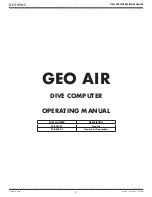
10-6
Status Structure
Model 6487 Reference Manual
mat) parameter type is used to send decimal values and does not use a header. The follow-
ing examples show the proper parameter syntax for setting bits B5, B3, and B2:
#b101100
Binary format (<NDN> parameter type)
#h2C
Hexadecimal format (<NDN> parameter type)
#q54
Octal format (<NDN> parameter type)
44
Decimal format (<NRf> parameter type)
Valid characters for the non-decimal parameter values are shown as follows:
Reading registers
Any register in the status structure can be read by using the appropriate query (?) com-
mand. The following explains how to interpret the returned value (response message). The
actual query commands are covered later in this section (
The response message will be a value that indicates which bits in the register are set. That
value (if not already binary) will have to be converted to its binary equivalent. For exam-
ple, for a binary value of 100101, bits B5, B2, and B0 are set.
The returned value can be in the binary, decimal, hexadecimal, or octal format. The
FORMat:SREGister command is used to select the data format for the returned value
(
).
For non-decimal formats, one of the following headers will accompany the returned value
to indicate which format is selected:
#B = Header for binary values,
#H = Header for hexadecimal values,
#Q = Header for octal values.
<NDN> Format
Valid Characters
Binary
1’s and 0’s
Hexadecimal
0 through 9 and A through F
Octal
0 through 7
Table 10-2
SCPI command — data formats for reading status registers
Command
Description
Default
:FORMat
:SREGister <name>
FORMat subsystem
Select data format for reading status registers:
<name>= ASCii
Decimal format
HEXadecimal Hexadecimal format
OCTal
Octal format
BINary
Binary format
ASCii
















































